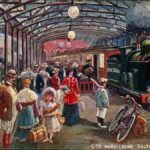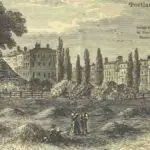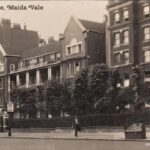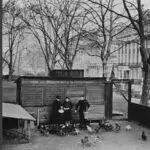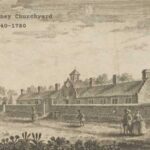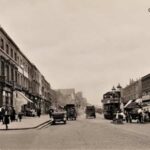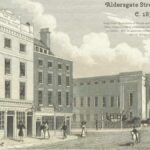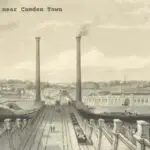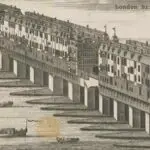Glimpse the past through old images of Covent Garden, London.
Roman Settlement in Covent Garden
Part of the Roman road to Silchester ran along what is now the Strand, aong the southern boundary of today’s Covent Garden area of London.
A late Roman grave, possibly about 410AD, was found in excavations at St Martin-in-the-Fields in 2006.
In the 600s AD, the Covent Garden area was at the centre of a trading town called Lundenwic, which stretched from the area of present-day Trafalga Square across to Aldwych.
Surpringly, Lundenwic completely disappeared after Alfred the Great moved to Londinium, an old Roman town, in 886AD, and the area returned to fields.
Medieval Covent Garden
In 1200AD, the Benedictine monks of the Abbey of St Peter, Westminster, had a walled garden in the area, which a couple of generations later was known as ‘the garden of the Abbot and Convent of Westminster’.
We know that in the 13th century, the 40-acre (16 ha) garden contained mixed orchard, meadow, pasture, and arable land. It was a quadrange, lying between the modern-day London streets of St Martin’s Lane, Drury Lane, Floral Street, and Maiden Lane.
Where does the name Covent Garden come from?
The medieval market garden belonged to the monastery and convent, and an Anglo-French term for a religious community was Covent. So Covent Garden described who owned the land and what it was used for.
In 1515, the words ‘a garden called Covent Garden’ appear in a legal document for the first time. The Abbey of St. Peter, Westminster. was granting a lease of the walled garden. They had already been renting out parcels of land for inns and market gardens along the north side of the Strand.
Bedford Estate at Covent Garden
The dissolution of the Monasteries under the English Reformation of Henry VIII put religious property first into the ownership of the crown, and then into the hands of private, well connected individuals.
Covent Garden, along with Long Acre, a seven acre plot to the north of Covent Garden, was seized in 1540.
King Edward VI granted Covent Garden to John Russell, 1st Earl of Bedford, in 1552. John Russell’s father had been a trusted advisor to King Edward’s father, Henry VIII.
The Bedford Estate existed at Covent Garden from 1552 until 1918.
Bedford House was built as the Russell seat, on Covent Garden land. The entrance to the grand house was on the Strand, and the large garden stretched back along the south side of the walled-off convent garden.
In 1630, King Charles I complained about the condition of the road an houses along Long Acre. Francis Russell, 4th Earl of Bedford, and Henry Carey, 2nd Earl of Monmouth, who were responsible for this area, complained that a 1625 Proclomation restricting building in and around London meant they could not build new houses to resolve the issue.
King Charles I gave Russell permission to build as many houses on his land as he saw fit – after Russell had paid £2,000 into the royal coffers. That was a staggering amount of money at the time.
Russell got straight to work, commissioning famous architect Inigo Jones to design and oversee a building scheme for the site. A church and three grand terraces were built around a large square, attracting wealthy residents.
The south side of the square saw a market appear around 1654, bringing in its wake coffee houses, taverns, and prostitutes, and the wealthy families sought accommodation elsewhere. Later, Harris’s List of Covent Garden Ladies, describing prostitutes and where to find them, demonstrated the extent to which this trade operated in the area.
Then William Russell, Lord Russell, married Rachel Wriothesley, the heiress of Bloomsbury, a former manor to the immediate north of Covent Garden. This union expanded the Bedford Estate.
On 11 May 1694, the Russell family were advanced further, bestowed with the title Duke of Bedford.
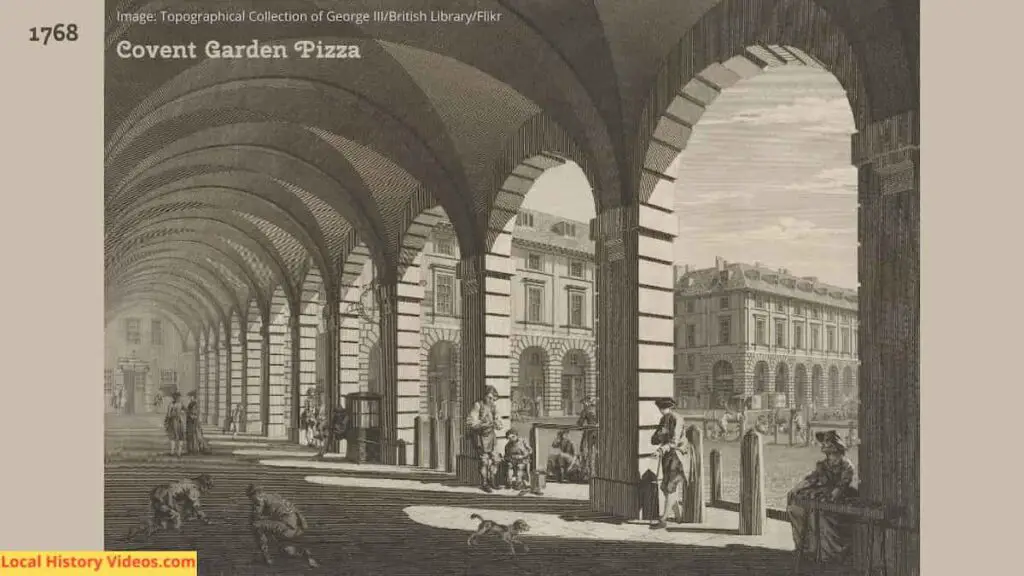
Theatre Royal
The first Theatre Royal at Covent Garden was opened in the 1660s. When it burnt down, the Theatre Royal Drury Lane was built on the same site, opening in 1674. It was knocked down more than a century later, making way for the much larger new Theatre Royal which operated from 1795 to 1809.
Unfortunately fire also claimed this building, in 1809.
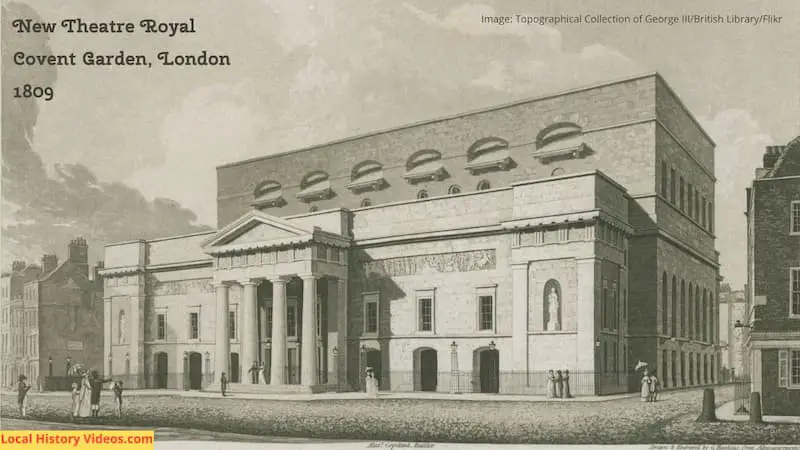
The site was once again used for a replacement theatre building, which opened in 1812. It has stood the test of time, and still operates today.
Market Hall 1830
Providing a more permanent trading centre in the area, a market hall designed by Charles Fowler was built in Covent Garden in 1830.
End of the Bedford Estate at Covent Garden
Herbrand Russell, 11th Duke of Bedford, agreed to sell the Covent Garden estate in 1913. Harry Mallaby-Deeley, an MP and land speculator, agreed to pay £2 million.
It turned out to be a terrible deal for the buyer. The following year the Great War, later known as World War I, broke out. By the time Mallaby-Deeley sold his option to the Beecham family in 1918, the year the war ended, he only received £250,000.
The Beecham Estates and Pills Limited owned Covent Garden between 1924 and 1928, when it was transferred to another compay part-owned by the Beechams, called Covent Garden Properties. They sold some of the local properties, using the money to invest in property across other parts of London.
Market Traders 1950
Two minutes of silent footage recorded in 1950 shows what an important commercial centre Covent Garden’s streets once were.
Various – Covent Garden (1950) – British Pathé on YouTube
In 1962, the newly established government body the Covent Garden Authority paid £3,925,000 for the market and bulk of remaining properties in the area.
They had plans to rip down the historic market, since the facilites and local roads were completely unsuitable for modern vehicles, and redevelop the area.
Redevelopment Plans 1971
In 1971, local people fought hard to save their community. The local authority wanted to rehouse tenants and tear their homes down for redevelopment.
But that would mean leaving all the friends and relatives they saw on a daily basis.
Even the policeman was happy to take a protest leaflet to read later.
The final word is given to a man who says that the area’s redevelopment will lead to high costs of living and the working classes will be pushed away by the middle classes.
1970s Covent Garden | Locals refuse to be moved! | 1970s London | Have your say | Today | 1971: ThamesTv (YouTube)
Thankfully this caused an outcry, leading to the listing of the buildings around the square in 1973.
Instead, the market found new premises in Nine Elms.
The Covent Garden market was redeveloped as a shopping centre in 1980, becoming one of London’s tourist hot spots. It was sold, along with several other properties in the area, to a property investment company in 2006.
In 2021, the average cost of a flat in the Covent Garden area was almost £1.5 million, well beyond the majority of households in the UK.
More about London
- Old Images of the London Underground Victoria Line
- Old Images of the Chelsea Pensioners, London: Old Age Lived Well
- Old Images of Chelsea Arts Ball
- Old Images of London Streets
- Old Images of London Roads
- Old Images of Marylebone Station
- Old Images of Marylebone, London
- Old Images of the Regent’s Canal, London
- Old Images of Maida Vale, London
- Old Images of Knightsbridge, London
- Old Images of Hyde Park and Hyde Park Corner, London
- Old Images of Chelsea Flower Show
- Old Images of Belgravia, London
- Old Images of Stepney, London
- Old Images of Old Kent Road (including the tragic teenaged war hero)
- Old Images of Aldersgate, City of London
- Old Images of Camden, North West London
- Old Images of Covent Garden
- Old Images of London Bridge
- Old images of Tower Bridge in London




